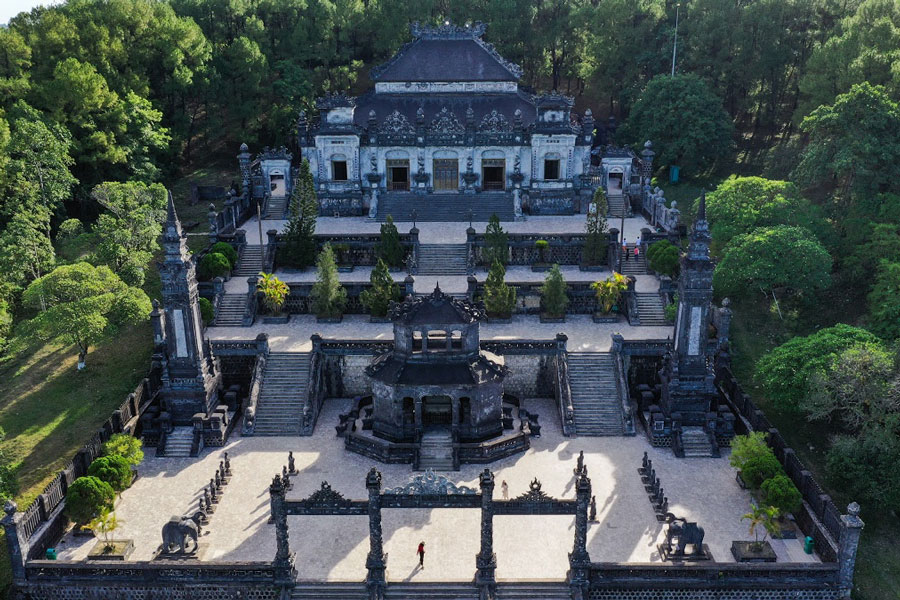Khai Dinh Mausoleum

Discover the allure of Khai Dinh Tomb in Hue, Vietnam, a captivating blend of traditional Vietnamese and French colonial architectural styles. Explore the rich history and cultural tapestry of early 20th-century Vietnam as you wander through the intricately adorned courtyards, halls, and chambers of this mausoleum. Uncover the legacy of Emperor Khai Dinh, whose final resting place on Chau Chu Mountain provides a picturesque backdrop to the unique mosaics and sculptures that grace the exterior. Immerse yourself in the harmonious integration of Eastern and Western influences within the tomb's interior, creating a truly enchanting experience. Plan your visit with Asia King Travel to Khai Dinh Tomb for an immersive journey into Vietnam's past, marked by a synthesis of cultures and a visual feast of architectural wonders.
 Khai Dinh Mausoleum in Hue
Khai Dinh Mausoleum in Hue
Embark on a mesmerizing journey through time and culture with a visit to the enchanting Khai Dinh Mausoleum, gracefully nestled amidst the serene landscapes of Hue, Vietnam. This architectural masterpiece, commissioned by Emperor Khai Dinh during his reign from 1916 to 1925, unfolded its construction narrative from 1920 to 1931, encapsulating a pivotal epoch in Vietnamese history marked by the intricate interplay of sociopolitical dynamics and the influential presence of French colonial forces.
As a living testament to this historical juncture, Khai Dinh Mausoleum reflects the emperor's visionary attempt to bridge the realms of traditional Vietnamese architectural aesthetics with the nuances of European design. The resulting synthesis is a captivating fusion, mirroring the cultural tapestry woven during a transformative period in Vietnam's past.
.jpg) Statues in front of Khai Dinh mausoleum
Statues in front of Khai Dinh mausoleum
Perched majestically on the slopes of Chau Chu Mountain, the mausoleum transcends its role as a final resting place for Emperor Khai Dinh to emerge as an enduring symbol of resilience and cultural identity. The sacred halls and courtyards, adorned with intricate mosaics and captivating sculptures, invite visitors into a realm where history and aesthetics harmonize in a visual symphony.
Delving deeper into the heart of Khai Dinh Mausoleum, tourists are transported through layers of time, unraveling the stories embedded in its walls. Each step becomes a profound exploration of Vietnam's rich heritage, a tapestry interwoven with the indomitable spirit that persevered through the challenging historical circumstances of the era.
Khai Dinh Mausoleum's architecture is a captivating fusion of traditional Vietnamese aesthetics and the influences of Western design, notably reflecting the French colonial era. Commissioned by Emperor Khai Dinh and constructed between 1920 and 1931, this architectural marvel in Hue, Vietnam, invites visitors into a realm where cultural synthesis takes center stage. The grand entrance staircase, adorned with intricate dragon sculptures, symbolizes Vietnamese heritage, while the entrance gate features European-inspired statues and reliefs, signaling the intersection of East and West.
 Architecture of Khai Dinh Mausoleum Hue
Architecture of Khai Dinh Mausoleum Hue
The pièce de résistance, the Thien Dinh main hall, boasts an interior adorned with vibrant mosaics crafted from glass and ceramic, narrating scenes that seamlessly blend Vietnamese themes with European flair. The deliberate use of modern materials and construction techniques underscores a departure from convention, offering a unique perspective on the evolving architectural landscape of Vietnam. Positioned on Chau Chu Mountain, Khai Dinh Mausoleum not only stands as a testament to the emperor's vision but also as a living canvas where history, culture, and architectural ingenuity converge in a harmonious spectacle.

Nghi Mon Gate and Bai Dinh Yard

Thien Dinh Palace

The bronze statue of King Khai Dinh

Khai Dinh Mausoleum, situated in the historic city of Hue, Vietnam, experiences a tropical monsoon climate characterized by distinct wet and dry seasons. The hot and humid conditions prevail throughout the year, with temperatures ranging from 25°C to 35°C (77°F to 95°F). The wet season, from September to November, brings heavy rainfall and elevated humidity, while the dry season, spanning from December to April, offers lower humidity and less precipitation. It's worth noting that the central region, including Hue, is susceptible to typhoons during the typhoon season from August to November. Visitors often find the months from December to April to be the most comfortable for exploring Khai Dinh Mausoleum, with milder temperatures and reduced humidity.
The best time to visit Khai Dinh Mausoleum Hue Vietnam is from January to February.
The months of March to April are considered particularly favorable. During these periods, the weather is relatively mild, with lower humidity and minimal rainfall, providing comfortable conditions for exploring the outdoor aspects of the mausoleum, such as its picturesque surroundings and the ascent to Chau Chu Mountain.
However, it's important to note that Vietnam's climate can vary, and the months of March and April may experience higher temperatures. To avoid crowds and make the most of your visit, it's advisable to plan your trip during the shoulder seasons of February to March.
To embark on a journey to Khai Dinh Mausoleum in Hue, Vietnam, several transportation options await travelers. If arriving by air, Phu Bai International Airport serves as the nearest gateway, offering convenient access to the city. For those favoring the scenic route, the train station in Hue provides rail connections from major cities like Hanoi and Ho Chi Minh City. Long-distance buses are also available, linking Hue to various destinations across Vietnam. Once in Hue, navigating the local terrain is facilitated by taxis, cyclos, and motorbike rentals. Khai Dinh Mausoleum, situated approximately 10 kilometers from the city center, can be reached by hiring a taxi, utilizing a motorbike taxi, or even renting a motorbike for a more independent exploration. Guided tours with inclusive transportation are also a popular choice for an enriching experience on the road to this architectural marvel, seamlessly blending tradition with modern convenience. If you have any questions about the itinerary, please contact Asia King Travel immediately for support.
See more: Discovery Ninh Binh - Hoa Lu & Trang An full day trip